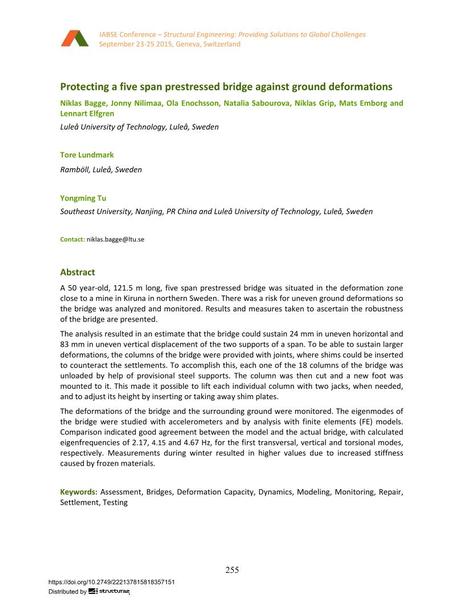Protecting a five span prestressed bridge against ground deformations

|
|
|||||||||||
Bibliographic Details
| Author(s): |
Niklas Bagge
Jonny Nilimaa (Luleå University of Technology, Luleå, Sweden) Ola Enochsson (Luleå University of Technology, Luleå, Sweden) Natalia Sabourova (Luleå University of Technology, Luleå, Sweden) Niklas Grip (Luleå University of Technology, Luleå, Sweden) Lennart Elfgren Mats Emborg (Luleå University of Technology, Luleå, Sweden) Tore Lundmark (Ramböll, Luleå, Sweden) Yongming Tu (Southeast University, Nanjing, PR China and Luleå University of Technology, Luleå, Sweden) |
||||
|---|---|---|---|---|---|
| Medium: | conference paper | ||||
| Language(s): | English | ||||
| Conference: | IABSE Conference: Structural Engineering: Providing Solutions to Global Challenges, Geneva, Switzerland, September 2015 | ||||
| Published in: | IABSE Conference Geneva 2015 | ||||
|
|||||
| Page(s): | 255-262 | ||||
| Total no. of pages: | 8 | ||||
| Year: | 2015 | ||||
| DOI: | 10.2749/222137815818357151 | ||||
| Abstract: |
A 50 year-old, 121.5 m long, five span prestressed bridge was situated in the deformation zone close to a mine in Kiruna in northern Sweden. There was a risk for uneven ground deformations so the bridge was analyzed and monitored. Results and measures taken to ascertain the robustness of the bridge are presented. The analysis resulted in an estimate that the bridge could sustain 24 mm in uneven horizontal and 83 mm in uneven vertical displacement of the two supports of a span. To be able to sustain larger deformations, the columns of the bridge were provided with joints, where shims could be inserted to counteract the settlements. To accomplish this, each one of the 18 columns of the bridge was unloaded by help of provisional steel supports. The column was then cut and a new foot was mounted to it. This made it possible to lift each individual column with two jacks, when needed, and to adjust its height by inserting or taking away shim plates. The deformations of the bridge and the surrounding ground were monitored. The eigenmodes of the bridge were studied with accelerometers and by analysis with finite elements (FE) models. Comparison indicated good agreement between the model and the actual bridge, with calculated eigenfrequencies of 2.17, 4.15 and 4.67 Hz, for the first transversal, vertical and torsional modes, respectively. Measurements during winter resulted in higher values due to increased stiffness caused by frozen materials. |
||||
| Keywords: |
settlement bridges testing modeling deformation capacity repair assessment dynamics monitoring
|
||||

